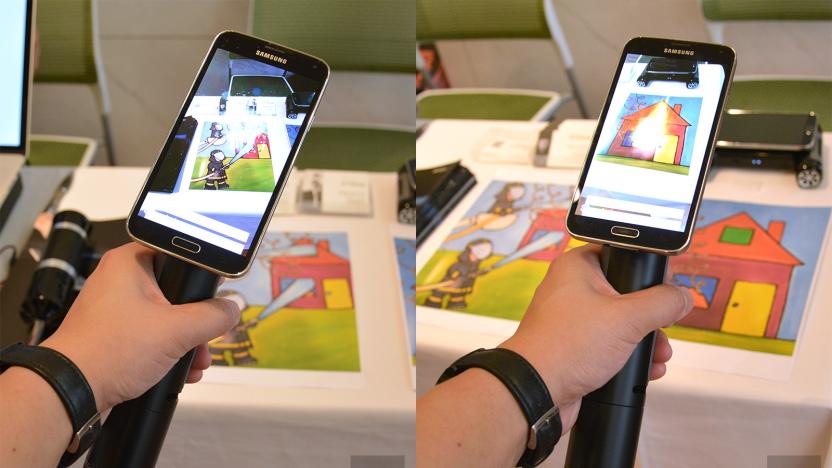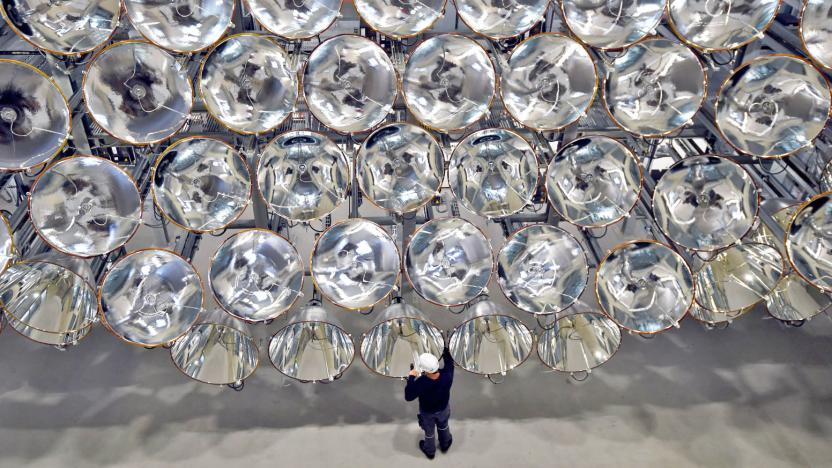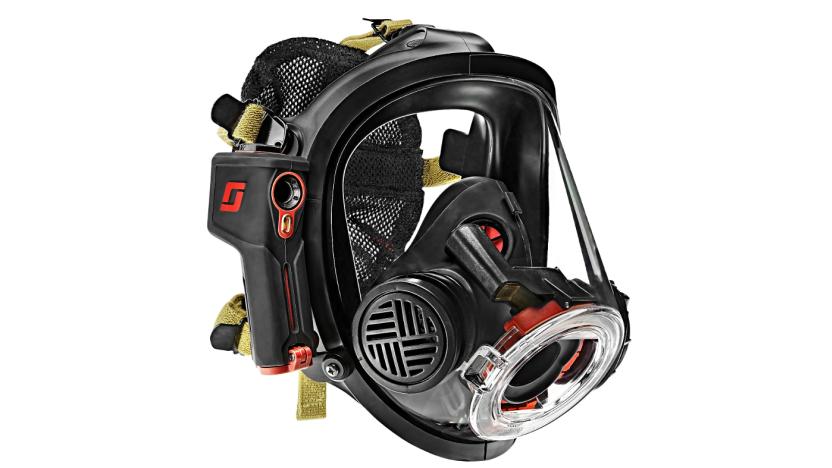thermal
Latest

Microsoft Research uses AI to help drones soar like eagles
Microsoft is looking to the skies for its next round of AI inspiration. Specifically, Redmond's Research division is using the birds that capture columns of warm air to glide around without expending much energy to guide its work. So far, it's been able to keep a 16.5 foot, 12.5 pound sailplane in the air thanks in part to algorithms that aid the craft in finding and using the thermals.

Plastics breakthrough could improve your car's mileage
A new thermal engineering process could make it viable to use lighter plastic product components in things such as vehicles, LEDs and computers. Until now, the material has been overlooked for certain applications because of its limitations in dissipating heat, but scientists from the University of Michigan have found a way to change plastic's molecular structure, making it as thermally conductive as glass. This advanced plastic could make products lighter, cheaper and more energy-efficient, and would be particularly useful in electric vehicle manufacturing since weight has a direct bearing on range.

ThermoReal lets you feel heat, cold and even pain in VR and AR
While some companies are trying to make AR and VR more immersive via haptic feedback, one startup decided to focus on the thermal aspects of the experience. TEGway, a spin-off of the Korea Advanced Institute of Science and Technology, has created a slim, flexible thermo-electric device (or "TED" in short) that can rapidly heat up or cool down, covering a temperature range of 4 to 40 degrees Celsius (39.2 to 104 degrees Fahrenheit). Better yet, it can simultaneously produce both heat and cold in different zones on the same surface, which enables the simulation of a pinch on one's skin to produce pain. Now packaged as ThermoReal, the company is hoping hardware makers will integrate this solution into the likes of joysticks, gloves, haptic suits, chairs and more for a new level of immersiveness.

German researchers built a molecule-splitting artificial sun
Scientists from the German Aerospace Center (DLR) are testing a novel way to generate hydrogen, a potential green energy source, by using a massive array of lights normally found in movie theaters.

Firefighter mask offers hands-free thermal imaging
When firefighters tackle a dangerous blaze, thermal imaging can be their greatest ally. It's usually integrated in a small handheld camera, helping team members to quickly locate civilians, peak through walls and identify safe passageways. Tyco's Scott Safety has now developed a face mask which includes an integrated thermal camera and display, called "Scott Sight." A small image is shown inside the mask -- similar to how Google Glass' would appear in your peripheral vision -- at nine frames per second, for up to four hours. The user can also switch between four different interfaces, as well as ambient and max temperature settings.

FLIR's second-generation thermal camera now works with (almost) any smartphone
When FLIR launched its first smartphone-based thermal camera at last year's CES, the biggest annoyance people had was that the hardware was baked into an iPhone 5 case. Anyone who wasn't toting Apple's newest two smartphones was understandably aggrieved about that decision. That's why, as a do-over, the company has released a second-generation FLIR One that clips onto the bottom of your smartphone over Lightning or micro-USB, letting Android users in on the fun.

Bring thermal vision to your phone with this camera add-on
For the most part, smartphone peripherals can make your mobile devices even more powerful than they already are. A new add-on, dubbed Seek Thermal, aims to do just that by bringing extra imaging features to your handset. The tiny gadget can be attached to an iPhone or Android smartphone (via Lightning port and microUSB, respectively) and, thanks to a companion app, turn that otherwise common device into one with a thermal camera. Seek Thermal notes it wants to help users across different scenarios, such as being aware of what's around them at night time or, why not, look at clogged pipes throughout the household, just to mention a couple. If you're interested, be ready to pay a premium -- both the iPhone and Android models are priced at $199 a piece. While you think about it, check out the demo past the break, courtesy of Android Police.

Scientists use nanotechnology to harvest electricity from temperature fluctuations
So far your footsteps, breath and nervous energy have all been tapped to charge up batteries, and now researchers from the Georgia Institute of Technology scientists have pulled it off using thermal changes. They did it with so-called pyroelectric nanogenerators, which use polarization changes to harvest heat energy from temperature fluctuations. Normally output current is too low for commercial electronics, but by making one with lead zirconate titanate (PZT), the team was able to create a device that could charge a Li-ion coin battery to power a green LED for a few seconds. The researchers predict that by doubling the surface area, they could drive wireless sensors or LCDs using only environmental temperature changes from an engine or water pipe, for instance. The result could be green power, but without all that pesky moving around.

Intel caught using cheap thermal paste in Ivy Bridge?
For all the good stuff it brings, Ivy Bridge has also been running a little hotter than reviewers and overclockers might have liked -- and that's putting it mildly. A few weeks back, Overclockers discovered a possible culprit: regular thermal paste that sits between the CPU die and the outwardly-visible heatspreader plate. By contrast, Intel splashed out on fluxless solder in this position in its Sandy Bridge processors, which is known have much greater thermal conductivity. Now, Japanese site PC Watch has taken the next logical step, by replacing the stock thermal paste in a Core i7-3770K with a pricier aftermarket alternative to see what would happen. Just like that, stock clock temperatures dropped by 18 percent, while overclocked temperatures (4GHz at 1.2V) fell by 23 percent. Better thermals allowed the chip to sustain higher core voltages and core clock speeds and thereby deliver greater performance. It goes to show, you can't cut corners -- even 22nm ones -- without someone noticing, but then Apple could have told you that.

Researchers working on thermal cloak, Predators trill their disapproval
Slathering yourself with mud to avoid head-hunting aliens is great and all, but it ain't exactly the paragon of good personal hygiene. Fortunately, researchers have concocted a cleaner and less cakey defense against Predators that's more likely to be mom approved. Fresh on the heels of the microwave invisibility project at the University of Texas at Austin, French researchers have found a way to make a cloak that can hide a subject from thermal imaging devices. The concept uses alternating materials with varying rates of diffusion to move heat around and create a thermally invisible region. Conversely, the technique can be used to concentrate heat in one spot so it gets hot rapidly. Although it doesn't quite have the wow factor of Cornell's invisibility project, the thermal research may prove to be more practical because it also can be used to manage heat and improve cooling in components such as computer chips. Of course, the question now is, can it be used to cloak an entire tank?

Apple addresses supposed iPad heat issues
Apple contacted The Loop with a statement about the iPad heating issue that is making the rounds this week. Apple representative Trudy Muller said, The new iPad delivers a stunning Retina display, A5X chip, support for 4G LTE plus 10 hours of battery life, all while operating well within our thermal specifications. If customers have any concerns they should contact AppleCare. I've had the new iPad since launch and my experience with it mirrors that of Jim Dalrymple. I've used it with games like Asphalt 6: Adrenaline HD, iPhoto, iMovie and more without any noticeable change in temperature. Temperature-wise, it feels just like my iPad 2. New iPad owners, chime in the comments with your experiences. Do you notice any overheating or is your new iPad as cool as a cucumber?

Infrared images show new iPad screen running warm
Remember when we said there were reports that the new iPad was running hot? Thanks to the folks at Tweakers.net, we now have some quantitative measurements to support these observations. The Dutch website ran a GLBenchmark test on the new iPad and the iPad 2 and compared the infrared profiles of each device. According to their measurements, the hottest part of the new iPad reached 33.6 degrees Celsius (92.5 degrees Fahrenheit), while the iPad 2 ran at a cooler 23.8 degrees Celsius (74.8 degrees Fahrenheit). You can see the differences in the image above where the new iPad is on the left and the iPad 2 on the right. The team at Tweakers attributed this difference to the quad-core GPU of the new iPad. When its being stressed by a benchmark test, the GPU will generate extra heat that'll raise the temperature of the device. Though high, the levels measured by Tweakers were still within the operating limits of the device which are 32 degrees to 95 degrees Fahrenheit (0 degrees to 35 degrees Celsius). Even if more reports corroborate these results, this excess heat issue won't be a problem for most people. If you game a lot and live in a warm climate, you might have to watch your usage, but most people don't stress their devices with heavy gaming. Under normal usage, the iPad might get slightly warm, but it shouldn't climb to the point where the device regularly shuts down. [Via Engadget and MacRumors]

That's hot: Heat-based recording could boost magnetic drive speed, performance
Magnetic fields are pretty nifty for levitating stuff, carving sponge-like thingamajigs and, of course, data storage. But an international team led by the University of York in the UK has figured out a way to replace magnetic fields for the latter by using ultra-short heat pulses instead. Conventional thinking typically dictates that an external magnetic field is required to store data on a magnetic medium. By using heat, however, researchers were able to record terabytes of information per second in a way that is also more energy-efficient compared to current hard drive technology. As for the time it'll take for the tech to make it to market, well, we have a feeling it won't be as fast.

Erasable e-paper shown off, erased, shown off again (video)
Researchers at Taiwan's Industrial Technology Research Institute are giving the world a peek at i2R, a new type of easily erasable e-paper. The technology uses a thermal printer and cholestric liquid crystals, letting users write and erase its contents up to 260 times. It can print different colored inks and could potentially be used for things like ID badges and signage. The sheets currently cost around $2 a piece to produce and should be available to us consumer types in about two years.

US Army wants thermally adaptive shirts, less of that nasty B-O
War-making apparel is about functionality just as much as fashion. That's why the US Army is offering a cool $1million in research funds to anyone who can help realize its dream of "thermally responsive textiles." The ultimate goal is clothing that automatically tailors itself to rapid changes in ambient and body temperature, thereby removing the need for alternative garments and reducing the weight and 'cube' of a soldier's payload. So-called smart fabrics have already been demonstrated by army scientists, based on comfy-sounding metallic fibers that curl up when it's cold and straighten out when it's warm. That sort of technology just needs to be reworked to make it practical and laundry-safe. We don't want those strong colors bleeding out in the wash, because as the line goes: if you're going to fight, you might as well clash.

NASA's new cooling pump doesn't need moving parts, set to chill out in space next month
It's pretty easy to cool down an overheating desktop computer with an extra fan, but what do you do if there's no air? That's the hurdle NASA's engineers are hoping to clear with a new prototype pump that the agency unveiled last week. The pinkie-sized instrument relies upon a technology known as electrohydrodynamic (EHD)-based thermal control, which uses electric fields to inject coolant through small vents on a thermal cold plate, before moving the extra heat to a radiator and spreading it far away from any temperature-sensitive areas. With no moving parts, the lightweight cooler uses only about half a watt of power and can be sized to work with small electric components or lab-on-a-chip devices. The challenge is to make sure that the pump can survive the vibrations of a rocket launch, though NASA will put it to the test during a rocket mission on June 9 and in 2013, when an EHD thermal cold plate will be placed on the International Space Station. Start your countdown clock and blast past the break for a full press release. [Thanks, Kevin]

Hawaiian volcano in sped up, thermal video: pretty intense
The United States Geological Survey's thermal camera recently captured some wild stuff over at the Kilauea volcanic caldera in Hawaii. The video (which is below) has been sped up four times, and shows a 450 foot-wide vent which is usually obscured by gas fumes.The results are impressive and overwhelming. Check it out.

Researchers teach liquid to flow uphill, hope to cool future CPUs (video)
Another day, another experimental CPU cooling method that may or may not come to pass. We've seen "thermal paste" from IBM and polyethylene from MIT, and now researchers at the University of Rochester have developed a method for coaxing water along nanometer-scale grooves carved into silicon. So hydrophilic are the patterns that water will even flow against gravity (and we've got the video to prove it). Not only are the structures so precise and nondestructive that the surface feels smooth to the touch, but they also trap photons, according to The New York Times, "so the grooved silicon appears pitch-black." And who knows? Maybe your next PC will be cooled by streams of water flowing freely inside the case. It's a nice image, anyways. Peep the video after the break to see it in action for yourself.

Heat diodes give thermal computing a fighting chance
Anyone who has tried their hand at overclocking recognizes just how evil waste heat is, and we're guessing that one Wataru Kobayashi at Waseda University in Japan understands explicitly. He, along with a few colleagues, has recently devised a new diode that allows heat current to travel in one direction but not in the other. The breakthrough essentially paves the way for thermal computing to actually take off, with obvious applications including heat sinks for microprocessors. Kobayashi, who may or may not be able to eat a dozen hot dogs per minute in his spare time, also hopes that his discovery will lead to a thermal transistor, thermal logic gates and a thermal memory. The future's yours, friend.

Patent Roundup: 'Hover' touch surfaces, liquid-cooled laptops
Two Apple patent filings have piqued interest this week: One for a touch surface that detects where your finger is hovered above it, and another for a liquid-cooled laptop. The hover surface works by measuring light reflected off your finger at various wavelengths to figure out where it is over the surface. Apple uses a basic proximity sensor in the iPhone (so it knows when it's up against your ear), but this new technique would allow more precise recognition of objects hovered above a touch-sensitive surface. Unlike a graphics tablet, which requires a stylus, your finger or hand is likely the intended tool for this surface, as evidenced by the drawings. Second, the liquid-cooled laptop, as with similarly-cooled Power Mac G5s from a few years ago, is designed to improve performance by reducing the temperature of the components of the computer. The patent describes wrapping a small heat pipe around various components in the computer that contains a liquid coolant. Liquid-cooled G5s, though, were prone to leaks, which led to heavy damage and dismay for users of the systems. Apple entirely replaced many of the systems that leaked, rather than trying to repair them. [Via Electronista and AppleInsider.]













